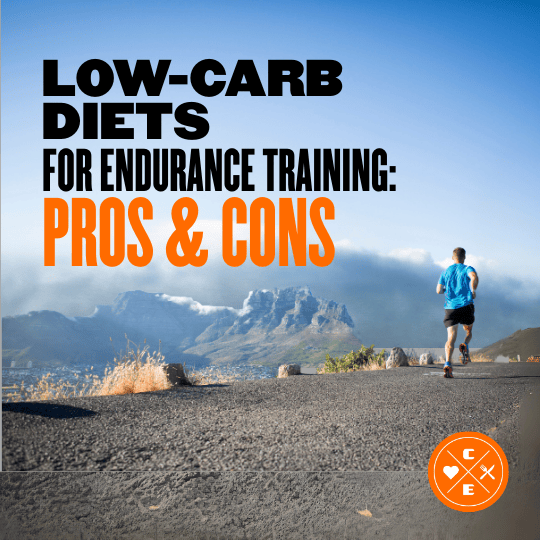Low-Carb Diets for Endurance Training: Pros and Cons

Jason Nista
Nutrition
|
Exercises & Fitness
|
Weight Loss
05/02/2025 11:05am
8 minute read
Table of Contents
Can low-carb diets improve endurance training? It depends on your goals and workout intensity. Low-carb diets can boost fat oxidation and endurance in low-intensity activities but may reduce performance during high-intensity efforts. Here's what you need to know:
- Benefits: Increased fat burning (+35–50%), better fasted performance (+22%), and potential glycogen preservation (75–80%).
- Drawbacks: Reduced sprint power (−8–12%) and glycolytic capacity (−18%), plus possible "keto flu" during the initial 2–4 weeks.
- Costs: Low-carb diets average $16.40/day vs. $12.75/day for standard diets.
- Nutritional Needs: Watch for magnesium and potassium deficiencies.
For busy athletes, pre-made low-carb meal services like Clean Eatz Kitchen can simplify meal prep, starting at $8.99 per serving. They offer portion-controlled, customizable options to align with your training.
Quick Tip: Test how your body responds to low-carb diets during training, and adjust based on performance and recovery needs.
Low Carb Diets For Endurance Athletes
1. Low-Carb Diet Basics for Athletes
Endurance athletes following low-carb diets typically consume 20–50 g of net carbohydrates daily, making up just 5–10% of their total calorie intake. This is a sharp contrast to the USDA's recommendation of 45–65% carbs.
Here’s a general macronutrient breakdown for athletes on low-carb diets:
| Nutrient | Daily Percentage | Key Sources |
|---|---|---|
| Fats | 60–75% | Avocados, nuts, olive oil |
| Protein | 20–30% (1.2–2.0 g/kg body weight) | Lean meats, fish |
| Carbs | 5–10% (<50 g net) | Non-starchy vegetables |
Research shows the body undergoes a three-phase adjustment process when transitioning to a low-carb diet, as outlined by the University of Connecticut:
1. Initial Adaptation (2–4 weeks)
Athletes may experience a temporary drop in performance and symptoms often referred to as "keto flu."
2. Performance Recovery (5–8 weeks)
A 2024 Journal of Sports Science study noted that while VO2 max levels remained stable, power output during high-intensity intervals dropped by 12–15%.
3. Peak Adaptation (3+ months)
Fat oxidation rates increase significantly, reaching up to 2.3 g per minute, which supports improved endurance at sub-maximal levels. The FASTER Study found that adapted athletes retained 75–80% of their muscle glycogen levels.
"The metabolic flexibility gained through proper low-carb adaptation can provide significant advantages for ultra-endurance events", explains Dr. Jeff Volek, a leading sports nutritionist. "However, the transition period requires careful management and monitoring."
Nutritional Adjustments and Costs
Athletes on low-carb diets often need to address potential deficiencies in key minerals. A 2023 NCAA survey reported that 68% of low-carb athletes lacked adequate levels of:
- Magnesium: Recommended daily intake is 400–420 mg.
- Potassium: Recommended daily intake is 4,700 mg.
Additionally, the cost of maintaining a low-carb diet can be higher. According to 2025 USDA data, low-carb diets average $16.40 per day ($492 monthly) compared to $12.75 daily ($382.50 monthly) for standard diets. Budget-conscious athletes can save by planning meals strategically and buying frozen proteins in bulk.
Performance Impacts
Data from TrainingPeaks highlights how low-carb diets affect performance for endurance athletes:
| Performance Metric | Change |
|---|---|
| Fat oxidation | +35–50% |
| Fasted state performance | +22% |
| Sprint power | -8–12% |
| Glycolytic capacity | -18% |
While low-carb diets can improve fat oxidation and endurance during lower-intensity activities, they may reduce performance in high-intensity efforts. Athletes need to consider these trade-offs carefully, balancing their diet with their specific training and competition goals.
2. Clean Eatz Kitchen Meal Plans
![]()
Endurance athletes transitioning to a low-carb diet often face the challenge of planning meals that meet their nutritional needs. Clean Eatz Kitchen simplifies this process by offering low-carb meal delivery designed to support athletic performance. Below, we’ll explore how their menu and pricing can help you stay on track.
Nutrition and Performance Support
Clean Eatz Kitchen offers a rotating monthly menu with portion-controlled meals tailored to low-carb diets. These chef-prepared meals are ready to eat after just a quick reheat, making them a practical choice for busy athletes.
| Meal Plan Feature | Benefits for Athletes |
|---|---|
| Flexible Macro Adjustments | Adapts to different training phases |
| No Subscription Required | Order meals as needed for specific cycles |
| Monthly Menu Rotation | Keeps meal options varied and engaging |
| Nationwide Delivery | Ensures consistency even while traveling |
For athletes, maintaining a balanced diet is just as important as keeping it affordable, especially during extended training periods.
Cost-Effective Training Support
Clean Eatz Kitchen’s pricing is designed with affordability in mind, making it easier for athletes to stick to their nutrition plans:
- Meals start at just $8.99 each
- Free shipping on orders over $85
- No subscriptions or long-term commitments required
- Bulk ordering options to lower overall costs
Convenience and Compliance
This service is tailored to help athletes overcome common hurdles during demanding training schedules:
Time Management
Fully prepared meals save valuable time, allowing you to focus on training instead of cooking.Portion Control
Each meal is carefully portioned, simplifying macro tracking and ensuring you stay aligned with your dietary goals.Travel Support
With nationwide delivery, you can maintain your low-carb diet even during competitions or training camps away from home.
sbb-itb-1989a25
Benefits and Limitations
Low-carb diets can aid in weight management and maintaining a balanced nutrient intake. However, individual responses can differ, so some adjustments may be necessary to find what works best for you.
Adjustment Considerations
Switching to a low-carb diet can affect your energy levels and performance, especially during the initial transition. Pay attention to how your body reacts and tweak your nutrition to meet your training needs. This process is similar to how athletes fine-tune their diets for high-intensity endurance activities.
Practical Meal Planning
Sticking to a consistent meal plan is essential when transitioning to a low-carb diet. Pre-prepared meals can make it easier to stay on track. Factors like your training intensity, personal preferences, and how your body metabolizes food will play a big role in how successful this diet is for you.
Conclusion
Opting for a low-carb diet as part of your endurance training plan requires thoughtful consideration of your personal goals and the intensity of your workouts. While this approach can help improve fat usage for energy and assist with weight management, it’s not a one-size-fits-all solution.
Success with a low-carb diet depends heavily on planning. Having pre-portioned, ready-to-eat meals can make the transition smoother and help you stay consistent. For example, Clean Eatz Kitchen offers meal plans designed to balance macronutrients specifically for low-carb training, combining convenience with nutritional needs.
To get the most out of your performance, keep these factors in mind:
- Training intensity: Higher-intensity sessions may call for carefully timed carbohydrate intake.
- Recovery: Prioritize protein and pay attention to portion sizes to support muscle repair.
- Individual response: Track your energy and performance as your body adjusts to the diet.
Tailor your low-carb approach to fit your endurance goals and daily routine. Whether you go all-in or make adjustments along the way, having access to nutritious, balanced meals will be a key component in achieving success with your training.
FAQs
What’s the best way for athletes to adjust to a low-carb diet without hurting their performance?
Transitioning to a low-carb diet can be challenging for athletes, especially during the initial adaptation phase. To minimize performance dips, it’s important to gradually lower carb intake rather than making drastic changes overnight. This allows your body to adjust to using fat as its primary energy source.
Stay hydrated and ensure you’re getting enough electrolytes like sodium, potassium, and magnesium to avoid symptoms of the so-called keto flu. Incorporating healthy fats, such as avocados, nuts, and olive oil, can also support energy levels during this period. Lastly, consider scheduling lower-intensity workouts during the first couple of weeks to give your body time to adapt without overexertion.
How can you make sure you're getting enough magnesium and potassium on a low-carb diet?
Maintaining adequate magnesium and potassium levels on a low-carb diet is important for overall health and optimal performance during endurance training. You can include foods rich in these minerals that align with your low-carb goals. For magnesium, consider adding spinach, almonds, and pumpkin seeds to your meals. For potassium, avocados, salmon, and leafy greens are excellent choices.
If you're looking for convenient, healthy meal options tailored to your dietary needs, Clean Eatz Kitchen offers fully-cooked, portion-controlled meals that can help you stay on track with your low-carb diet while ensuring balanced nutrition. Their rotating menu includes customizable plans, making it easier to meet your fitness and endurance goals.
How can endurance athletes manage their carbohydrate intake during high-intensity training on a low-carb diet?
Balancing carbohydrate intake on a low-carb diet during high-intensity endurance training can be challenging but achievable with proper planning. Athletes can focus on timing their carb consumption strategically, such as consuming small amounts of fast-digesting carbs before or during intense workouts to maintain energy levels. This approach helps fuel performance without significantly disrupting the principles of a low-carb diet.
Additionally, incorporating nutrient-dense, low-carb foods high in healthy fats and proteins can support recovery and overall energy needs. For convenient, healthy meal options tailored to specific dietary goals like low-carb or high-protein, consider pre-prepared meals that align with your fitness plan. Maintaining hydration and electrolyte balance is also crucial for optimal performance on a low-carb diet.
Related Articles
10 Veggie Swaps for Common Carb Ingredients
15 minute read
How to Cook Balanced Meals in a Microwave
9 minute read



